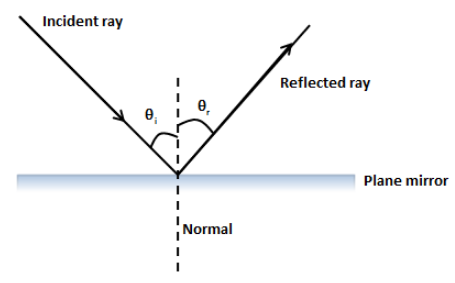
A ray of light falls on a plane mirror and the angle of incidence is \[25^\circ \]. What is the angle of reflection?
A. \[0^\circ \]
B. \[50^\circ \]
C. \[90^\circ \]
D. \[25^\circ \]
Answer
550.8k+ views
Hint: Recall the laws of reflection. The law of reflection states that when a ray of light reflects off a surface, the angle of incidence is equal to the angle of reflection. Make the necessary ray diagram of the reflection of light ray off the plane mirror to support your answer.
Complete step by step answer:
To understand the laws of reflection, let’s draw the ray diagram of the reflection of light ray from the plane mirror as shown in the figure below.

In the above diagram, the light rays which are approaching the plane mirror are known as incident rays and the ray which is leaving the plane mirror is known as reflected ray. The line perpendicular to the mirror where the incident ray meets the plane mirror is known as normal. We always define the angle of incidence which is the angle made by the incident ray with the normal and the angle made by the reflected ray with the normal is the angle of reflection.
Now, one of the laws of reflection states that the normal line divides the incident ray and reflected ray equally from the normal. Therefore, we can say that the angle of incidence equals the angle of reflection.In the given question, the angle of incidence is \[25^\circ \].Therefore, from the law of reflection, we can say that the angle of reflection is also \[25^\circ \].
So, the correct answer is option D.
Note:The laws of reflection are valid for only plane mirrors. In case of the surface which is rough and has bulges on the surface, the angle of reflection cannot be equal to the angle of incidence. The angle of reflection does not depend upon the properties of the plane mirror and the refractive index of the medium since the light ray reflects in the same medium.
Complete step by step answer:
To understand the laws of reflection, let’s draw the ray diagram of the reflection of light ray from the plane mirror as shown in the figure below.

In the above diagram, the light rays which are approaching the plane mirror are known as incident rays and the ray which is leaving the plane mirror is known as reflected ray. The line perpendicular to the mirror where the incident ray meets the plane mirror is known as normal. We always define the angle of incidence which is the angle made by the incident ray with the normal and the angle made by the reflected ray with the normal is the angle of reflection.
Now, one of the laws of reflection states that the normal line divides the incident ray and reflected ray equally from the normal. Therefore, we can say that the angle of incidence equals the angle of reflection.In the given question, the angle of incidence is \[25^\circ \].Therefore, from the law of reflection, we can say that the angle of reflection is also \[25^\circ \].
So, the correct answer is option D.
Note:The laws of reflection are valid for only plane mirrors. In case of the surface which is rough and has bulges on the surface, the angle of reflection cannot be equal to the angle of incidence. The angle of reflection does not depend upon the properties of the plane mirror and the refractive index of the medium since the light ray reflects in the same medium.
Recently Updated Pages
Why is there a time difference of about 5 hours between class 10 social science CBSE

In cricket, what is a "pink ball" primarily used for?

In cricket, what is the "new ball" phase?

In cricket, what is a "death over"?

What is the "Powerplay" in T20 cricket?

In cricket, what is a "super over"?

Trending doubts
Who was the first woman to receive Bharat Ratna?

Who Won 36 Oscar Awards? Record Holder Revealed

State and prove the Pythagoras theorem-class-10-maths-CBSE

State BPT theorem and prove it class 10 maths CBSE

What is the minimum age for fighting the election in class 10 social science CBSE

Describe the Salient Features of Indian Economy




